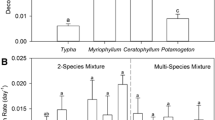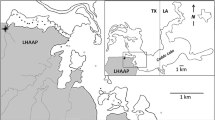Abstract
We describe and evaluate a laboratory bioassay that uses Lemna minor L. and attached epiphytes to characterize the status of ambient and nutrient-enriched water from the Portneuf River, Idaho. Specifically, we measured morphological (number of fronds, longest surface axis, and root length) and population-level (number of plants and dry mass) responses of L. minor and community-level (ash-free dry mass [AFDM] and chlorophyll a [Chl a]) responses of epiphytes to nutrient enrichment. Overall, measures of macrophyte biomass and abundance increased with increasing concentrations of dissolved phosphorus (P) and responded more predictably to nutrient enrichment than morphological measures. Epiphyte AFDM and Chl a were also greatest in P-enriched water; enrichments of N alone produced no measurable epiphytic response. The epiphyte biomass response did not directly mirror macrophyte biomass responses, illustrating the value of a combined macrophyte–epiphyte assay to more fully evaluate nutrient management strategies. Finally, the most P-enriched waters not only supported greater standing stocks of macrophyte and epiphytes but also had significantly higher water column dissolved oxygen and dissolved organic carbon concentrations and a lower pH. Advantages of this macrophyte–epiphyte bioassay over more traditional single-species assays include the use of a more realistic level of biological organization, a relatively short assay schedule (~10 days), and the inclusion of multiple biological response and water-quality measures.





Similar content being viewed by others
References
Allan, J. D., & Castillo, M. M. (2007). Stream ecology: Structure and function of running waters. The Netherlands: Springer.
APHA. (2005). Standard methods for the examination of water and wastewater (21st ed.). Washington DC: American Public Health Association, American Water Works Association, and Water Environment Federation.
Baker, J. H., & Orr, D. R. (1986). Distribution of epiphytic bacteria on freshwater plants. Journal of Ecology, 74, 155–165.
Baker, J. H., & Farr, I. S. (1987). Importance of dissolved organic matter produced by duckweed (Lemna minor) in a Southern English river. Freshwater Biology, 17, 325–330.
Beardall, J., Young, E., & Roberts, S. (2001). Approaches for determining phytoplankton nutrient limitation. Aquatic Sciences, 63, 44–69.
Bechtold, H. A., Marcarelli, A. M., Baxter, C. V., & Inouye, R. S. (2012). Effects of N, P, and organic carbon on stream biofilm nutrient limitation and uptake in a semi-arid watershed. Limnology and Oceanography, 57, 1544–1554.
Carpenter, S. R. (1996). Microcosm experiments have limited relevance for community and ecosystem ecology. Ecology, 77, 677–680.
Carpenter, S. R., & Lodge, D. M. (1986). Effects of submersed macrophytes on ecosystem processes. Aquatic Botany, 26, 341–370.
Carr, G. M., & Chambers, P. A. (1998). Macrophyte growth and sediment phosphorus and nitrogen in a Canadian Prairie river. Freshwater Biology, 39, 525–536.
Clarke, S. J. (2002). Vegetation growth in rivers: Influences upon sediment and nutrient dynamics. Progress in Physical Geography, 26, 159–172.
Drenner, R. W., Mazumder, A., Carpenter, S. R., & Huston, M. A. (1999). Microcosm experiments have limited relevance for community and ecosystem ecology: Comments and reply. Ecology, 80, 1081–1089.
Eriksson, P. G., & Weisner, S. E. B. (1999). An experimental study on the effects of submerged macrophytes on nitrification and denitrification in ammonium-rich aquatic ecosystems. Limnology and Oceanography, 44, 1993–1999.
Fitzgerald, G. P. (1969). Some factors in the competition or antagonism among bacteria, algae and aquatic weeds. Journal of Phycology, 5, 351–359.
Güsewell, S., & Koerselman, W. (2002). Variation in nitrogen and phosphorus concentrations of wetland plants. Perspectives in Plant Ecology, 5, 37–61.
Hilton, J., O’Hare, M. T., Bowes, M. J., & Jones, J. I. (2006). How green is my river? A new paradigm of eutrophication in rivers. Science of the Total Environment, 365, 66–83.
Hooper, F. F. (1969). Eutrophication indices and their relation to other indices of ecosystem change. In Review of eutrophication: Causes, consequences, correctives. Proceedings from a Symposium (pp. 225–235). Washington DC: National Academy of Sciences Publication 1700.
Hopkins, J. M., Marcarelli, A. M., & Bechtold, H. A. (2011). Ecosystem structure and function are complementary measures of water quality in a polluted, spring-influenced river. Water, Air, & Soil Pollution, 214, 409–421.
Les, D. H., Crawford, D. J., Landolt, E., Gabel, J. D., & Kimball, R. T. (2002). Phylogeny and systematics of Lemnaceae, the duckweed family. Systematic Botany, 27, 221–240.
Lin, H.-J., Nixon, S. W., Taylor, D. I., Granger, S. L., & Buckley, B. A. (1996). Responses of epiphytes on eel grass, Zostera marina L., to separate and combined nitrogen and phosphorus enrichment. Aquatic Botany, 52, 243–258.
Linton, S., & Goulder, R. (1998). The duckweed Lemna minor compared with the algal Selensastrum capricornutum for bioassay of pond-water richness. Aquatic Botany, 60, 27–36.
Madsen, J. D., & Adams, M. S. (1988). The seasonal biomass and productivity of the submerged macrophytes in a polluted Wisconsin stream. Freshwater Biology, 20, 41–50.
Marcarelli, A. M., & Wurtsbaugh, W. A. (2009). Nitrogen fixation varies spatially and seasonally in linked stream-lake ecosystems. Biogeochemistry, 94, 95–110.
Marcarelli, A. M., Rugenski, A. T., Bechtold, H. A., & Inouye, R. S. (2009). Nutrient limitation of biofilm biomass and metabolism in the Upper Snake River basin, southeast Idaho, USA. Hydrobiologia, 620, 63–76.
Mebane, C. A., Simon, N. S., & Maret, T. R. (2013). Linking nutrient enrichment and streamflow to macrophytes in agricultural streams. Hydrobiologia, 722, 143–158. doi:10.1007/s10750-013-1693-4.
Miller, W. E, Greene, J. C., & Shiroyama, T. (1978). The Selenastrum capricornutum Printz algal assay bottle test. Experimental design, application and data interpretation protocol. U.S. Environmental Protection Agency, EPA-600/9-78-018.
Millican, J. S., Back, J. A., & McFarland, A. M. S. (2008). Nutrient bioassays of growth parameters for algae in the North Bosque River of Central Texas. Journal of the American Water Resources Association, 44, 1219–1230.
Minshall, G. W., & Andrews, D. A. (1973). An ecological investigation of the Portneuf River, Idaho: A semiarid-land stream subjected to pollution. Freshwater Biology, 3, 1–30.
Mkandawire, M., Taubert, B., & Dudel, E. G. (2006). Limitation of growth-parameters in Lemna gibba bioassays for arsenic and uranium under variable phosphate availability. Ecotoxicology and Environmental Safety, 65, 118–128.
Mkandawire, M., Teixeira da Silva, J. A., & Dudel, E. G. (2013). The Lemna bioassay: contemporary issues as the most standardized plant bioassay for aquatic ecotoxicology. Critical Reviews in Environmental Science and Technology, 44, 154–197. doi:10.1080/10643389.2012.710451.
Neckles, H. A., Wetzel, R. L., & Orth, R. J. (1993). Relative effects of nutrient enrichment and grazing on epiphyte–macrophyte (Zostera marina L.) dynamics. Oecologia, 93, 285–295.
Onaindia, M., Amexaga, I., Garbisu, C., & García-Bikuña, B. (2005). Aquatic macrophytes as biological indicators of environmental conditions of rivers in North-Eastern Spain. Annales de Limnologie – International Journal of Limnology, 41, 175–182.
Pelton, D. K., Levine, S. N., & Braner, M. (1998). Measurements of phosphorus uptake by macrophytes and epiphytes from the LaPlatte River (VT) using 32P in stream microcosms. Freshwater Biology, 39, 285–299.
Penning, W. E., Mjelde, M., Dudley, B., Hellsten, S., Hanganu, J., Kolada, et al. (2008). Classifying aquatic macrophytes as indicators of eutrophication in European lakes. Aquatic Ecology, 42, 237–251.
R Development Core Team. (2011). R: A language and environment for statistical computing. R Foundation for Statistical Computing, Vienna. ISBN 3-900051-07-0. http://www.r-project.org. Accessed 14 March 2012.
Radić, S., Stipaničev, D., Cvjetko, P., Marijanović Rajčić, M., Širac, S., Pevalek-Kozlina, et al. (2011). Duckweed Lemna minor as a tool for testing toxicity and genotoxicity of surface waters. Ecotoxicology and Environmental Safety, 74, 182–187.
Ramsey, F. L., & Schafer, D. W. (2002). The statistical sleuth. A course in methods of data analysis. Pacific Grove: Duxbury Press.
Ray, A. M. (2010). Portneuf River total maximum daily load revision and addendum. Idaho Department of Environmental Quality. http://www.epa.gov/waters/tmdldocs/portneuf_river_revision_addendum_final.pdf. Accessed 3 October 2013.
Sand-Jensen, K., & Borum, J. (1991). Interactions among phytoplankton, periphyton, and macrophytes in temperate freshwaters and estuaries. Aquatic Botany, 41, 137–175.
Santamaría, L. (2002). Why are most aquatic plants widely distributed? Dispersal, clonal growth and small-scale heterogeneity in a stressful environment. Acta Oecologica, 23, 137–154.
Schindler, D. W. (1998). Replication versus realism: The need for ecosystem-scale experiments. Ecosystems, 1, 323–334.
Sengupta, S., Medda, C., & Dewanji, A. (2010). The impact of duckweed on water quality in sub-tropical ponds. Environmentalist, 30, 353–360.
Smith, V. H., Tilman, G. D., & Nekola, J. C. (1999). Eutrophication: Impacts of excess nutrient inputs on freshwater, marine, and terrestrial ecosystems. Environmental Pollution, 100, 179–196.
Soranno, P. A., Cheruvelil, K. S., Stevenson, R. J., Rollins, S. L., Holden, S. W., Heaton, S., et al. (2008). A framework for developing ecosystem-specific nutrient criteria: Integrating biological thresholds in predictive modeling. Limnology and Oceanography, 53, 773–787.
Spivak, A. C., Vanni, M. J., & Mette, E. M. (2011). Moving on up: Can results from simple aquatic mesocosm experiments be applied across broad spatial scales? Freshwater Biology, 56, 279–291.
Szabó, S., Braun, M., & Borics, G. (1999). Elemental flux between algae and duckweeds (Lemna gibba) during competition. Archiv für Hydrobiologie, 146, 355–367.
Taraldsen, J. E., & Norberg-King, T. J. (1990). New method for determining effluent toxicity using duckweed (Lemna minor). Environmental Toxicology and Chemistry, 9, 761–767.
Underwood, A. J. (1995). Toxicological testing in laboratories is not ecological testing of toxicology. Human and Ecological Risk Assessment, 1, 178–182.
USEPA. (2000). Nutrient criteria technical guidance manual: Rivers and streams. U.S. Environmental Protection Agency, EPA-822-B-00-002. http://www.epa.gov/waterscience/criteria/nutrient/guidance/rivers/index.html. Accessed 3 October 2013.
USEPA. (2013). National summary of impaired waters and TMDL information. U.S. Environmental Protection Agency. http://iaspub.epa.gov/waters10/attains_nation_cy.control?p_report_type=T. Accessed 3 October 2013.
Vadeboncoeur, Y., Vander Zanden, M. J., & Lodge, D. M. (2002). Putting the lake back together: Reintegrating benthic pathways into lake food web models. Bioscience, 52, 44–54.
Wang, W. C. (1990). Literature review on duckweed toxicity testing. Environmental Research, 52, 7–22.
Wang, W. C., & Freemark, K. (1995). The use of plants for environmental monitoring and assessment. Ecotoxicology and Environmental Safety, 30, 289–301.
Wetzel, R. G. (2001). Limnology: Lake and river ecosystems. San Diego: Academic Press.
Williams, S. L., & Ruckleshaus, M. H. (1993). Effects of nitrogen availability and herbivory on eelgrass (Zostera marina) and epiphytes. Ecology, 74, 904–918.
Acknowledgments
This work was supported by the National Science Foundation Undergraduate Mentoring in Environmental Biology program (UMEB 03-05289), the NSF-Idaho EPSCoR program (EPS 04-47689), the Inland Northwest Research Alliance (Department of Energy Contract #DE-FG02-05ER64132), the Center for Ecological Research and Education and the Stream Ecology Center at Idaho State University, and the Idaho Department of Environmental Quality. Field and laboratory support was also provided by the City of Pocatello, the Idaho Association of Soil Conservation Districts, and Three Rivers RC&D. The authors would also like to thank Kelsey Flandro, Stacey Raben, Jennifer Cornell, Heather Bechtold, and Colin Warnock for field and laboratory assistance. Any use of trade, product, or firm names is for descriptive purposes only and does not imply endorsement by the US Government.
Author information
Authors and Affiliations
Corresponding author
Electronic supplementary material
Below is the link to the electronic supplementary material.
ESM 1
(DOCX 67 kb)
Appendix
Appendix
Rights and permissions
About this article
Cite this article
Ray, A.M., Mebane, C.A., Raben, F. et al. Evaluation of a combined macrophyte–epiphyte bioassay for assessing nutrient enrichment in the Portneuf River, Idaho, USA. Environ Monit Assess 186, 4081–4096 (2014). https://doi.org/10.1007/s10661-014-3682-0
Received:
Accepted:
Published:
Issue Date:
DOI: https://doi.org/10.1007/s10661-014-3682-0




